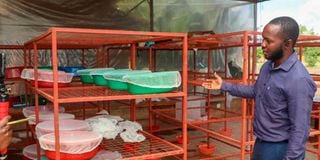Science to the rescue in effort to eradicate malaria

What you need to know:
- The pilot phase of the malaria vaccine was formally launched in Kenya in September 2019, in Ndhiwa, Homa Bay. Its phased introduction targeted eight counties comprising 26 malaria-endemic sub-counties in Kisumu, Homa Bay, Migori, Siaya, Kakamega, Bungoma, Vihiga and Bungoma.
- The Health ministry plans to roll out the vaccine to the rest of the counties in the coming months.
Does the female Anopheles mosquito infect humans with malaria or is it vice versa?
While research on this question points to the malaria parasite developing both in humans and in mosquitoes, scientists differ, with the lack of consensus arising from the genetic complexity of the parasite.
“It’s a chicken and egg situation,” Mr Halfan Ngowo, a research scientist at the Ifakara Health Institute (IHI) in Tanzania told HealthyNation during a recent visit.

But Mr Arnold Mmbando, also a research scientist at the same institute, unequivocally states: “It is man who infects the mosquito, which only acts as a vector that carries and transfers Plasmodium falciparum, the parasite that transmits malaria.”
According to Dr Fredros Okumu, a parasitologist and entomologist, who currently works as director of science at IHI, plasmodium, which causes malaria, is one of the few parasites in the world “that has evolved in such a way that part of its life cycle survives in human beings and the other part in mosquitoes.”
That means if an uninfected mosquito bites a person who is already carrying the plasmodium parasite, the parasite will be passed onto the mosquito and then transmitted to the next person.
The size and genetic complexity of the parasite, Dr Okumu expounds, translates to each infection presenting thousands of antigens in the form of proteins to the human immune system.
At IHI, the team of scientists are developing, testing and validating innovations to control malaria.
Ifakara village, located in the Kilombero District, Morogoro Region, south central Tanzania, hosts the world’s largest captive mosquito colony and has been dubbed the ‘mosquito city’.
This has inspired scientists to camp at the research centre to study the behaviour of the parasite in a country that has the third-largest population at risk of malaria infection in Africa.
“The mosquitoes we are breeding are free of malaria. Since the insects need a blood meal to reproduce, we ensure that the volunteers who feed our mosquitoes are malaria-free,” explains Mr Mmbando. A number of tactics under research at the organisation include developing mosquito traps, mimicking the odour of sweaty feet, testing the use of zapping nets, and eave screening to reduce the entry of mosquitoes into houses.
But over time, the malaria parasite has also evolved to resist a series of strategies that allow human beings to escape infections. Despite all efforts, they continue to fly, bite and kill.
“We observed a shift in mosquito biting to earlier hours of the evening, before individuals are indoors and protected by bed nets, followed by a return to pre-intervention biting rates,” notes Mr Mmbando, adding that although mosquitoes are nocturnal in nature, the time of biting no longer matters.
At Ifakara, mosquitoes being reared for research do not have any mosquito parasite. Demonstrating how hungry mosquitoes are being fed, Mr Mmbando puts his arm in a captive cage with more than 500 mosquitoes.
“We test the people who are going to feed the mosquitoes in the insectary, and if they are found to have the malaria parasite, they are not allowed to feed the insects,” adds Mr Mmbando.
In 2019, the Lancet Commission’s report on the world’s prospects of eradicating malaria concluded that ending the deadly malady was “no longer a dream, but is now possible in our lifetime.”
“For too long, malaria eradication has been a distant dream but now we have evidence that malaria can and should be eradicated by 2050," said Richard Feachem, co-chair of the Lancet Commission on Malaria Eradication.
Over the years, the world has made significant progress with more than half the countries in the world now being malaria-free according to the study. About 188 million insecticide-treated mosquito nets were distributed in 2020 and the number of children under five years who died of the disease plummeted.
Does this mean we are finally winning the war on malaria? Dr Okumu argues that we are miles away to achieving this.
The progress the world has been making against malaria has stalled even as new tools and treatments get developed and ambitious ideas like genome editing advanced through clinical research.
“To put it outrightly, we are losing this war,” he says.
His basis for arguing this is, although developing countries are recording significant progress, Africa has a mountain to climb given its burgeoning population where the current average age is 19 years according to Worldometer.
“Overall, the economic and public health burden is higher than it used to be because of population growth coupled with expensive preventive and curative methods.”
While the successes of the past few years have certainly narrowed the number of deaths attributed to malaria, Dr Okumu notes that stagnating financial support, weak health systems, lack of adequate domestic financing and multisectoral approaches and emerging resistance to front-line treatments for severe malaria in Africa are hurdles that continue to plague the fight against the disease.
For Mr Ngowo, looking at a 10-year period, there’s some progress in the war against malaria in Africa with the introduction of new tools like the new malaria vaccines, indoor residual spraying, and insecticide treatment.
In most countries where malaria is endemic, the disease disproportionately affects disadvantaged people who have limited access to health facilities and can barely afford the recommended treatment.
Too many people are still missing out on the malaria interventions they need, and more than half the world’s population is still unable to access health services without incurring financial hardship. “Most malaria-infected people who receive treatment in good time are fully cured and suffer no long-term effects,” Dr Okumu says.
In the case of Africa, most of the cases reported are in rural settings where health systems are weak. This means that if a person experiences fever and flu-like illness, they will not go to a clinic immediately. “They will delay, take over-the-counter medications and wait out the symptoms. This delay automatically reduces the efficacy of treatment and therefore the outcome is poor.”
New data from the WHO also reveals that the Covid-19 pandemic has disrupted malaria services, leading to a marked increase in cases and deaths.
“Here in Ifakara, everything but essential work stopped working due to the pandemic. Given the ongoing pandemic, there were significant delays in supply and delivery of bed nets,” explains Mr Ngowo.
“Applying a new cause-of-death methodology revealed that malaria has taken a considerably higher toll on African children every year since 2000 than previously thought,” says the latest WHO malaria report.
In 2019, Bill Gates warned that progress made in controlling malaria was slowing down, thanks to drug and insecticide resistance.
Drug resistance to antimalarials and insecticides used on bed nets and indoor and outdoor residual spraying has emerged as one of the greatest challenges facing malaria control today.
It has been implicated in the spread of malaria to new areas and the re-emergence of the disease in areas where it had been eradicated.
Reports of sporadic resistance to modern malaria drugs have begun appearing in recent years and are now confirmed in Rwanda and Uganda.
“Resistance is something we should worry about because it will be difficult to take care of young children and pregnant women who are the majority of the population at risk of developing severe malaria,” explains Mr Ngowo.
An even bigger problem is the lack of real-time data on the extent, impact, and magnitude of drug resistance. Resistance to chloroquine was once considered to be the magic bullet against malaria. But malaria parasites evolved to survive it, prompting the WHO and African governments to switch to artemisinin combination therapy (ACTs).
Because the ACTs are mixtures, Dr Okumu explains, it is difficult for malaria parasites to resist them.
However, soon after the introduction of the drugs, reports of resistance to artemisinins started to emerge, initially in south-east Asia.
Scientists and health practitioners now are increasingly concerned that the situation may worsen in the years to come. Front-line drugs remain largely effective, but the likelihood of widespread failure is growing fast.
“The good news is that resistance to artemisinins has not spread widely in Africa. African malaria parasites already have the genetic changes potentially associated with resistance to artemisinins. But the frequency of these changes is still very low,” says Dr Okumu. Climate change has also seen mosquitoes change their behaviour from predominantly found in temperate areas like western and coastal parts of Kenya to cooler regions such as central Kenya.
Long considered a rural disease, scientists in 2020 showed that malaria cases are increasing among city dwellers following the invasion of a new species of mosquito from Asia.
In recent years, an invasive vector species known as Anopheles stephensi that adapts easily in urban environments has been extending its range in Horn of Africa, with detections reported across Djibouti, Ethiopia, Somalia and Sudan.
So, can we eradicate malaria? On scientific grounds, eradicating malaria is complex and difficult. “Effective malaria control can only succeed by identifying, understanding, and targeting Anopheles species instead of killing all mosquitoes,” notes Mr Ngowo.
African countries, however, carry a disproportionately high burden of malaria cases. In Kenya, for instance, there are an estimated 3.5 million new clinical cases and 10,700 deaths each year, and those living in western Kenya have an especially high risk of malaria. Due to altitude, rainfall patterns, and temperature, about 70 per cent of the Kenyan population is at risk for malaria.
“It is hard to replicate the interventions the US and Europe made because the mosquito species prevalent in Africa is not the same as the ones in the west. The species in Africa are predominantly human dependent, meaning that they feed on human blood,” notes Dr Okumu.
But scientists say there’s no reason the world can’t do it altogether. In October 2021, WHO recommended the broad use of a vaccine for children aged six weeks to 17 months living in sub-Saharan Africa and in other regions with moderate to high Plasmodium falciparum.
The approval was based on a review of evidence on the RTS,S/AS01 vaccine (brand name Mosquirix), including results from a WHO-coordinated pilot programme that has reached more than 830,000 children in three African countries (Kenya, Uganda, and Malawi) since 2019 — that it is efficient.
To date, the pilot programme has shown that the vaccine is safe, has a substantial public health impact, and is highly cost-effective.
“If introduced widely, we estimate that the RTS,S/AS01 vaccine could save between 40,000 and 80,000 young lives every year – but only if it’s given a chance to work,” wrote Dr Pedro Alonso, director, WHO global malaria programme, last month.
The pilot phase of the vaccine was formally launched in Kenya in September 2019, in Ndhiwa, Homa Bay. Its phased introduction targeted eight counties comprising 26 malaria-endemic sub-counties in Kisumu, Homa Bay, Migori, Siaya, Kakamega, Bungoma, Vihiga and Bungoma.
The Health ministry plans to roll out the vaccine to the rest of the counties in the coming months.
Simply put, there is more work to be done to bring an end to malaria deaths within sight.





